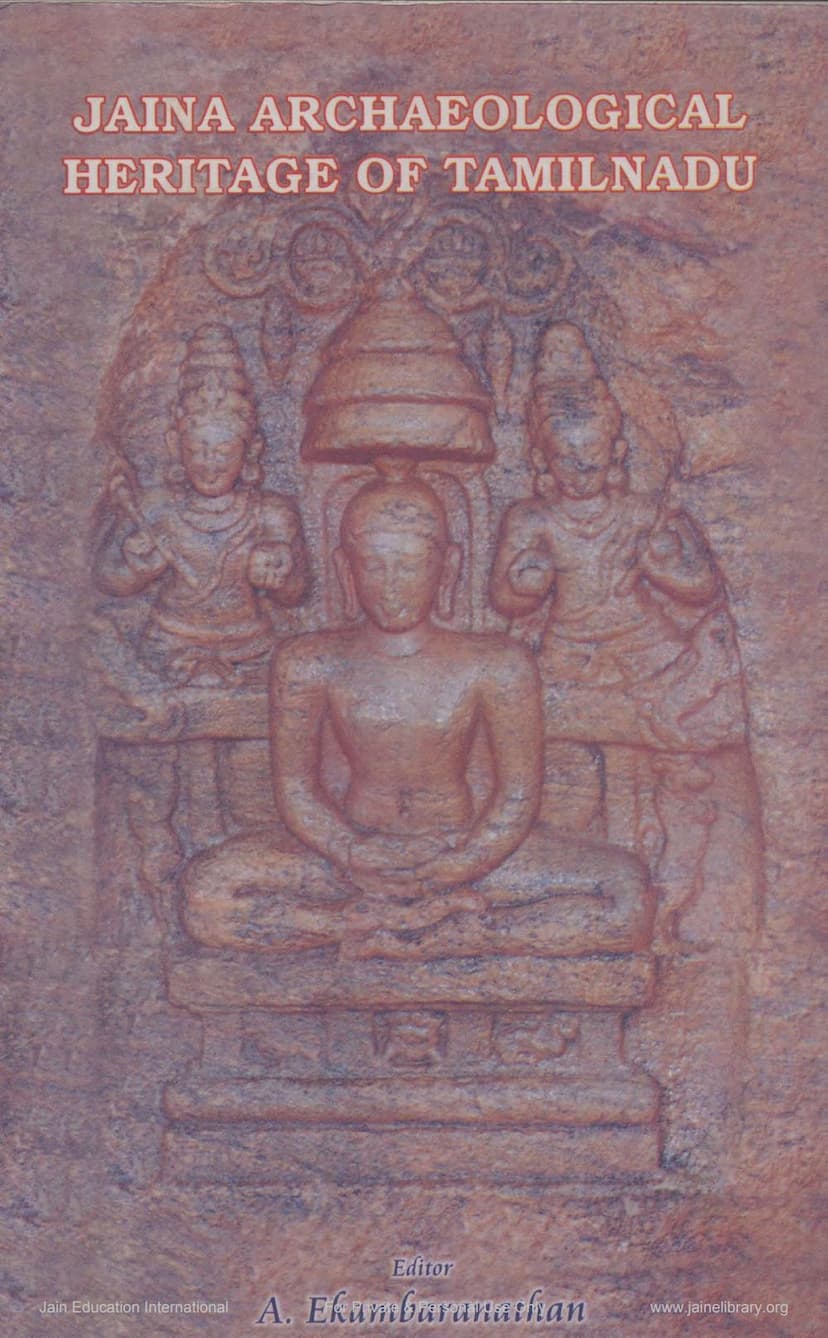Jaina Archaeological Heritage Of Tamilnadu
Added to library: September 2, 2025

Summary
This comprehensive book, "Jaina Archaeological Heritage of Tamilnadu," edited by A. Ekambaranathan, delves into the rich Jaina legacy in Tamil Nadu, spanning from ancient times to the modern era. Published by Shri Bharatvarshiya Digamber Jain (Teerth Sanrakshini) Mahasabha, it compiles ten research papers presented at a seminar organized by the Department of Ancient History & Archaeology, University of Madras. The publication aims to highlight the importance of Tamil Nadu's Jaina heritage and encourage further research.
The book systematically explores various facets of this heritage:
-
Early Jaina Caves: Sathyabhama Badhreenath details the discovery and significance of numerous natural caverns across Tamil Nadu that served as abodes for Jaina monks. These caves, often found at inaccessible heights, are characterized by polished stone beds and drip ledges, with their Jaina association confirmed by Brahmi inscriptions. Several key sites like Arittapatti, Mangulam, Kilavalavu, Alagarmalai, and Tiruparankunram are discussed, noting their early Brahmi inscriptions and later Jaina sculptural evidence.
-
Jaina Temples: A. Ekambaranathan provides an overview of the historical development of Jaina temples in Tamil Nadu, from their early roots in the 3rd century BC to modern times. The book highlights significant temples such as the Trailokyanatha Temple and Chandraprabha Temple at Tirupparuttikunram, Chittamur Temples (Malainatha and Parsvanatha), and temples at Tirunarungondai, Perumandur, Tirumalai (Kundavai Jinalaya), Ponnur, and Poondi. It discusses their architectural styles, patronage by ruling dynasties, and the evolution of Jaina religious practices.
-
Jaina Sculptural Art: A. Ekambaranathan also analyzes the extensive sculptural art of the Digambara Jainas in Tamil Nadu. The chapter notes the absence of sculptures in early caves, attributing it to Jainism's initial puritanical phase and aversion to image worship. It then traces the impact of the Bhakti movement and the subsequent adoption of anthropomorphic worship, leading to the creation of exquisite sculptures of Tirthankaras and attendant deities in rock-cut and structural temples. Various regional styles, dating from the 8th century AD onwards, are discussed, including those influenced by Karnataka art. The chapter also addresses the challenges in identifying Tirthankara images due to their similar iconography.
-
Jaina Bronzes: P.D. Balaji surveys the Jaina bronze icons found in Tamil Nadu, tracing their origins from the 8th century AD. He discusses bronze images of various Tirthankaras like Adinatha, Parsvanatha, Mahavira, Neminatha, Chandraprabha, and others, noting their stylistic evolution and the common presence of yakshas and yakshis. The chapter highlights the popularity of certain Tirthankaras and deities like Rishabhanatha, Dharanendra, Ambika, and Jvalamalini, and the influence of Karnataka art on Tamil bronze casting.
-
Jaina Paintings: R. Harini explores the rich tradition of Jaina paintings in Tamil Nadu, dating back to the Pallava period. The chapter details significant Jaina painting sites like Armamalai and Sittannavasal, focusing on their themes, techniques, and artistic significance. It discusses the depiction of Samavasarana, celestial dancers, royal figures, and the stories of Ambika Yakshi. Paintings at Tirumalai and Tiruparuttikunram are also analyzed, highlighting their narrative styles and the transition from early symbolic representations to later elaborate storytelling.
-
Protected Jaina Monuments: Sathyabhama Badhreenath provides an overview of Jaina monuments protected by the Archaeological Survey of India (ASI) in Tamil Nadu. The article categorizes these monuments into early natural caverns, rock-cut cave temples, and structural temples, detailing their salient features and locations. It emphasizes the conservation efforts undertaken by the ASI to preserve these historical sites.
-
Jaina Monasteries: Prof. S. Thanyakumar discusses the crucial role of Jaina monasteries, referred to as 'Pallls,' as centers of learning and culture. The chapter highlights the significant contributions of Jaina monks and nuns to literacy and the development of Tamil language. It traces the history of Jaina monastic orders in Tamil Nadu, focusing on important centers like Kurandi Tirukkattampalli, Sittannavasal, and various monastic establishments in Tondaimandalam. The chapter also touches upon the unique institution of lady preceptors and the modern mathas that continue the Jaina tradition.
-
Jaina Epigraphs: Dr. S. Rajavelu provides a detailed account of Jaina inscriptions found in Tamil Nadu, spanning from the 4th century BC to the 18th century AD. He discusses the antiquity of Jainism in Tamil Nadu, the significance of Tamil-Brahmi inscriptions, and the patronage Jainism received from various rulers and communities. The chapter also explores the monastic orders like Mula Samgha, Dravida Samgha, and Yapaniya Samgha, and the role of Jaina pallis and nunneries as documented in epigraphs.
-
Recently Discovered Jaina Inscriptions: Dr. P. Jayakumar presents an overview of recently discovered Jaina inscriptions from Tamil Nadu, focusing on those reported in the last ten years. The chapter highlights new findings from sites like Arittapatti, Tamaraikarai, Kilarasampattu, Mangadu, Kuvanur, Uranitangal, Vadugapatti, Kulattur, and Tirukogarnam, shedding light on the continuous presence and active patronage of Jainism in the region.
-
Jaina Manuscripts: Dr. C.K. Sivaprakasan analyzes Jaina manuscripts, particularly those from the Mackenzie collections, as a vital source for understanding the socio-cultural history of Jainism in Tamil Nadu. The chapter discusses various Jaina centers mentioned in these manuscripts, the legends associated with them, and the impact of Jaina monks and their teachings. It also touches upon the patronage of Yakshi cults and the role of monastic orders in preserving Jaina traditions.
Overall, "Jaina Archaeological Heritage of Tamilnadu" serves as a valuable resource for scholars, researchers, and anyone interested in the profound and enduring legacy of Jainism in Tamil Nadu, showcasing its artistic, architectural, literary, and religious contributions.